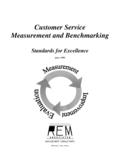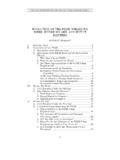Transcription of Estate Tax Study - CT.GOV-Connecticut's Official …
1 Estate Tax Study connecticut Department of revenue Services connecticut Office of Policy and Management February 1, 2008 Public Act 07-1, of the June Special Session, directed the Commissioner of revenue Services, in consultation with the Secretary of the Office of Policy and Management, to conduct a Study of the connecticut Estate tax and submit a report to the Governor and the joint standing committee of the General Assembly having cognizance of matters relating to finance, revenue and bonding. This report is in response to that directive and provides an overview of the history of the Estate tax, the current connecticut Estate tax, information on other states, tabulations and feedback from a survey sent to practitioners who provide Estate tax planning, migration patterns based on Internal revenue Service data and other research identified in our Study .
2 Both the Office of Policy and Management and the Department of revenue Services would like to extend their appreciation to the connecticut Society of Certified Public Accountants and the connecticut Bar Association, Estate Tax and Probate Section for their help in conducting the survey of practitioners. 2 The Federal Estate Tax History The federal Estate tax has been a feature of the tax code for much of the last two hundred years. A historical review shows a pattern of enactment and repeal. Enactment often occurred with the goal of raising revenue for a specific purpose, primarily, military spending. Repeal often occurred in times of economic prosperity when the specific revenue need decreased.
3 In 1797, the Stamp Act enacted a small graduated transfer tax in order to develop a strong navy. That tax was repealed in 1802. A series of acts created the federal inheritance tax in 1862-66 in order to finance the Civil War and was repealed in 1870. In 1898, the War revenue Act established an Estate tax to defray the costs of the Spanish American War and was repealed in 1902. Estate taxes became a permanent source of federal revenue with the enactment of the revenue Act of 1916. The Estate of a decedent who, at death owns assets valued in excess of the Estate tax exemption amount, is required to file a federal tax return. The federal form integrates gifts and the value of the Estate by adding lifetime gifts to the gross Estate to form the tax base, but allows a credit on the tax due for the value of the lifetime gift taxes paid.
4 Additionally, expenses and losses incurred in the administration of the Estate , funeral costs, and the decedent s debts are allowed as deductions against the Estate for the purpose of calculating the tax. A deduction is allowed for the full value of bequests to the surviving spouse, including bequests in which the spouse is given only a life interest, subject to certain restrictions. Bequests to qualified charities are also fully deductible. Estate tax law is based on the decedent s year of death and is due 9 months from the date of death. With the enactment of the Economic Growth and Tax Relief Reconciliation Act of 2001 (EGTRRA), Congress significantly altered the framework of the federal Estate tax.
5 The exemption amount for estates was increased incrementally from $675,000 to $3,500,000. The highest tax rate on estates was decreased from 55 percent to 45 percent. The following chart shows the changes made by the Act. Federal Estate Tax Changes (EGTRRA) Estate Top Estate Tax Tax Rate Year of Death Exemption (Percent) 1999 $650,000 55 2000 $675,000 55 2001 $675,000 55 2002 $1,000,000 50 2003 $1,000,000 49 2004 $1,500,000 48 2005 $1,500,000 47 2006 $2,000,000 46 2007 $2,000,000 45 2008 $2,000,000 45 2009 $3,500,000 45 3 Barring further Congressional action.
6 The Estate tax is repealed for deaths occurring in 2010 but will be reinstated for deaths occurring on or after January 1, 2011, at an exemption level of $1,000,000 and a top rate of 55 percent. The Effect of EGTRRA on States Prior to the passage of the EGTRRA, the federal government allowed a credit for state Estate taxes paid. The credit was based on the following schedule. Credit for State Death Taxes As of December 31, 2000 Taxable Estate Value Maximum Credit Not over $90,000 8/10th of 1% of the amount over $40,000 $90,001 to $140,000 $400 plus of the excess over $90,000 $140,001 to $240,000 $1,200 plus of the excess over $140,000 $240,001 to $440,000 $3,600 plus of the excess over $240,000 $440,001 to $640,000 $10,000 plus of the excess over $440,000 $640,001 to $840,000 $18,000 plus of the excess over $640,000 $840,001 to $1,040,000 $27,600 plus of the excess over $840,000 $1,040,001 to $1,540,000 $38,800 plus of the excess over $1,040,000 $1,540,001 to $2,040,000 $70,800 plus of the excess over $1,540,000 $2,040,001 to $2.
7 540,000 $106,800 plus of the excess over $2,040,000 $2,540,001 to $3,040,000 $146,800 plus of the excess over $2,540,000 $3,040,001 to $3,540,000 $190,800 plus of the excess over $3,040,000 $3,540,001 to $4,040,000 $238,800 plus of the excess over $3,540,000 $4,040,001 to $5,040,000 $290,800 plus of the excess over $4,040,000 $5,040,001 to $6,040,000 $402,800 plus of the excess over $5,040,000 $6,040,001 to $7,040,000 $522,800 plus of the excess over $6,040,000 $7,040,001 to $8,040,000 $650,800 plus of the excess over $7,040,000 $8,040,001 to $9,040,000 $786,800 plus of the excess over $8,040,000 $9,040,001 to $10,040,000 $930,800 plus of the excess over $9,040,000 $10,040,001 and over $1,082,800 plus 16% of the excess over $10,040,000 For example, if the gross federal taxable Estate was $7,250,000, which included $2,000,000 in lifetime gifts, the tentative tax would have been $3,628,300.
8 That amount would have been reduced by the unified credit on gift taxes paid of $220,550 and the credit for state Estate taxes paid of $671,200, making the net federal Estate tax due $2,736,550. Prior to passage of the EGTRRA, every state and the District of Columbia imposed an Estate tax equal to the federal credit for state Estate taxes paid, commonly referred to as the sponge tax. This effectively gave the states a part of the Estate tax that would otherwise be payable to the federal government. The credit for state Estate taxes paid was phased out in the EGTRRA. The credit decreased from 100% to 75% of the credit for state Estate taxes paid for 2002, to 50% for 2003 and 25% for 2004.
9 In 2005, the credit for Estate taxes paid was replaced by a deduction for state Estate taxes paid. Since state revenue was tied to the federal credit for Estate taxes, the reduction in the allowable credit translated into a loss in state revenue . 4 Actions by States Fifteen states that levied the sponge tax prior to 2001 have retained their Estate taxes. Of these, twelve states Illinois, Maine, Maryland, Massachusetts, Minnesota, New Jersey, New York, North Carolina, Oregon, Rhode Island, Vermont and Wisconsin decoupled from the federal Estate tax law and continue to levy an Estate tax that is the same or very similar to the Estate tax prior to the passage of the EGTRRA. Virginia also decoupled from federal Estate tax law but repealed their tax on July 1, 2007.
10 Three states, connecticut , Kansas and Washington replaced their sponge tax with an Estate tax that was similar to what they received from the sponge tax but is not tied to the federal tax. Nine states, Indiana, Iowa, Kentucky, Louisiana, Nebraska, Ohio, Oklahoma, Pennsylvania and Tennessee levy a state inheritance or Estate tax that was never tied to the federal sponge tax. Nebraska repealed their state inheritance tax for deaths occurring on or after January 1, 2007, however, they still levy an inheritance tax at the county level. Two states, Maryland and New Jersey levy both an Estate tax that is similar to the sponge tax prior to the passage of the EGTRRA and a separate inheritance tax.

















